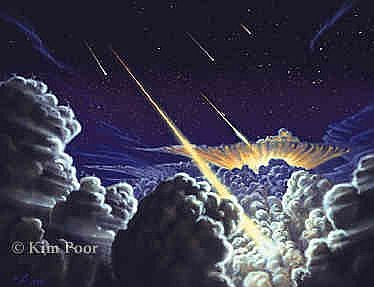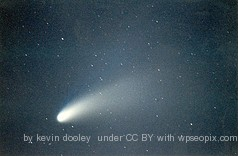Comets are icy bodies that emit gas and dust when warmed by the sun. They are composed of ice, dust, rocky particles, carbon dioxide, ammonia and methane. Sometimes they are referred to as `dirty snowballs’ or `cosmic snowballs’ because of their composition. Astronomers believe that comets are made up of condensed remnants of the cloud of gas, dust, ice and rocks from which the solar system formed.
Comets are interesting objects in the solar system. Here are some facts about them including their composition, orbital characteristics, popular comets and much more.
Comet Artwork Image Source: Night of Comets
What Is The Structure and Composition of Comets?
A comet has a nucleus, coma and tail. The nucleus is the center of the comet. It is composed of ice, gas and pieces of rock. It had not been seen directly and its appearance remained a mystery until when a spacecraft flew close to Halley’s Comet. The Deep Impact mission also provided insights into the nucleus of a comet.
When comets approach the sun, the ice, carbon dioxide and other materials heat up turn into gas and rise up forming an atmosphere that is referred to as the coma
The tail forms when the sun’s energy causes the coma to flow around the nucleus and form a tail behind it. The tail can be as long as a million miles. The gas molecules are ionized by sunlight and the solar wind pushes them to form an ion tail.
How Big Are Comets?
Comets vary in size. Some are extremely large while some are extremely small. Scientists have discovered comets that are as small as less than 1km in diameter and some that are as large as 300km in diameter.
Chiron is the comet with a 300km diameter. Since it spends its time in the outer parts of the solar system and never enters the inner solar system, it is not possible to see it from Earth.
Comets Orbit the Sun Too
Just like the planets and asteroids, comets revolve around the sun. They have a highly elliptical orbit that sometimes takes them very far away from the sun and sometimes brings them closer to the sun.
Based on the duration of their orbits, there are two types of comets. Short-period comets (periodic comets) orbit the sun in 200 years or less. Long-period comets have orbits that take more than 200 years even thousands of years to complete.
Where Do Comets Come From?
Comets are believed to originate from the extremely cold and distant outer sections of the solar system specifically the Kuiper Belt and Oort cloud.
The Oort cloud is a massive spherical cloud around the sun. It is believed to contain billions of comets that are so far away from the sun that it takes them thousands of years to complete an orbit. These are known as long period comets. A special case is Halley’s Comet which takes 76 years to orbit the sun but is believed to have originated from the Oort cloud. Other stars and forces in the galaxy sometimes disrupt the orbits of long period comets causing them to enter the inner solar system.
Sun-grazers are comets that originate from the Oort cloud and have an irregular and unpredictable orbit that sometimes take them very close to the sun such that they become so bright or smash into the sun. An example is Pan-STARRS.
The Kuiper Belt is a disc-shaped ring beyond Pluto’s orbit. Periodical comets that are closer to the sun originate from here.
Main-belt comets are comets found in the asteroid belt and scientists believe they could be sources of water to the inner terrestrial planers.
How Do Comets Acquire Their Names?
The name comet is derived from a Greek word, which means `hair of the head’. Comets were named so because Aristotle the Greek philosopher referred to them as `stars with hair’.
Individual Comets are named after the people who discover them or the missions that lead to their discovery. Shoemaker-Levy 9 was named so because it was the ninth comet discovered by Eugene and Carolyn Shoemaker and David Levy.
History of Comets
Comets have been visible for a long time. As early as 240 B.C, the ancient Chinese observed and recorded the appearance of Halley’s Comet. The ancient Greeks referred to comets as `stars with hairs’. Most ancient communities associated comets with tragedies and misfortunes.
Is It Possible To See Comets?
Unlike planets that maintain their position from the sun, most comets travel from their homes and pass close to the sun making it possible to see them from Earth. However, the majority of the comets are too small or too faint to be seen without a telescope.
As comets approach the sun, the coma and tail become visible. The sunlight hits the coma and tail and reflects the dust particles. The sun’s energy also causes some of the molecules to glow and form a bluish tail, which is known as an ion tail and a yellow tail made of neutral sodium atoms.
Comets that are so bright that they can be seen from earth with the naked eye are referred to as great comets and at least one appears every ten years.
The most recent comet to be seen was comet Hale-Bopp, which became visible in 1997 at a distance of 122 million miles (197 million kilometers) from Earth. It had a very large nucleus that emitted dust and gas and appeared very bright.
Comet Hale-Bopp Source: Kevin dooley
Comets Give Rise to Meteor Showers
Meteor showers occur when the Earth crosses the orbit of a comet. The dust and ice left behind when the comet passed creates multiple meteors leading to a meteor shower.
Can Comets Fall on Earth?
We know that it is possible for comets to impact earth. Scientists seek to understand the nature of comets so they can use this knowledge to design ways to protect the earth from comets that are on a path that may lead to a collision with earth.
Over the years, Comets have collided with planets and moons causing craters. In 1994, the comet Shoemaker-Levy 9 collided with Jupiter. Jupiter’s high force of gravity broke the comet into fragments, which collided with the planet at high speed and left more than 20 impact craters that remained visible for months. This event gave astronomers an opportunity to observe what could happen in the event of a comet colliding with a planet.
What are Interesting Facts about Halley’s Comet?
Named after Edmond Halley, the astronomer who first computed its orbit, Comet Halley is one of the most famous comets. It had been observed as early as thousands of years ago by the Babylonian, Chinese and European star gazers.
Edmond Halley Image Source
It is a short period comet and can be seen with the unaided eye every 75 to 76 years when it approaches the sun. The last time it was visible was in 1986 and will be visible again in 2061.



